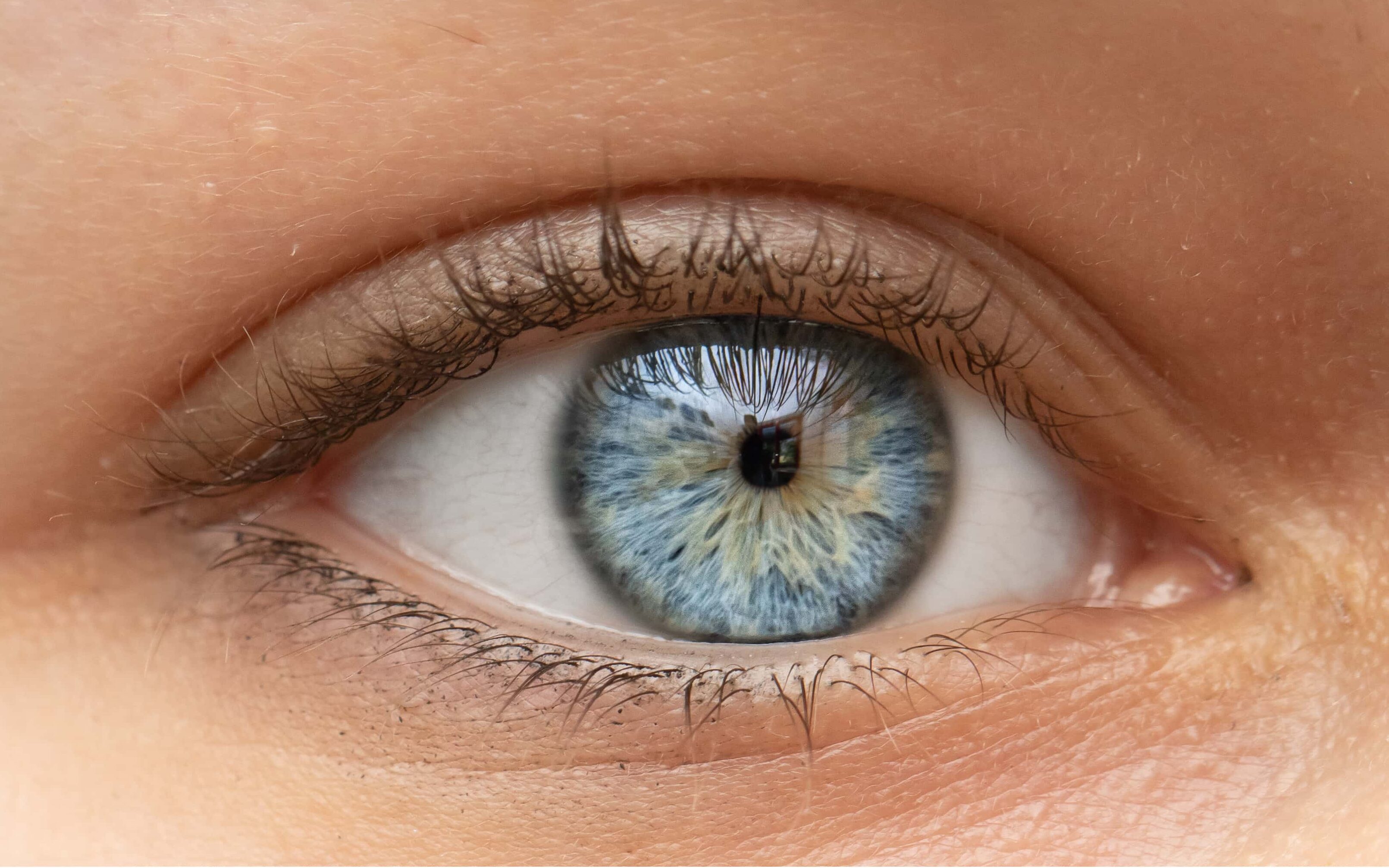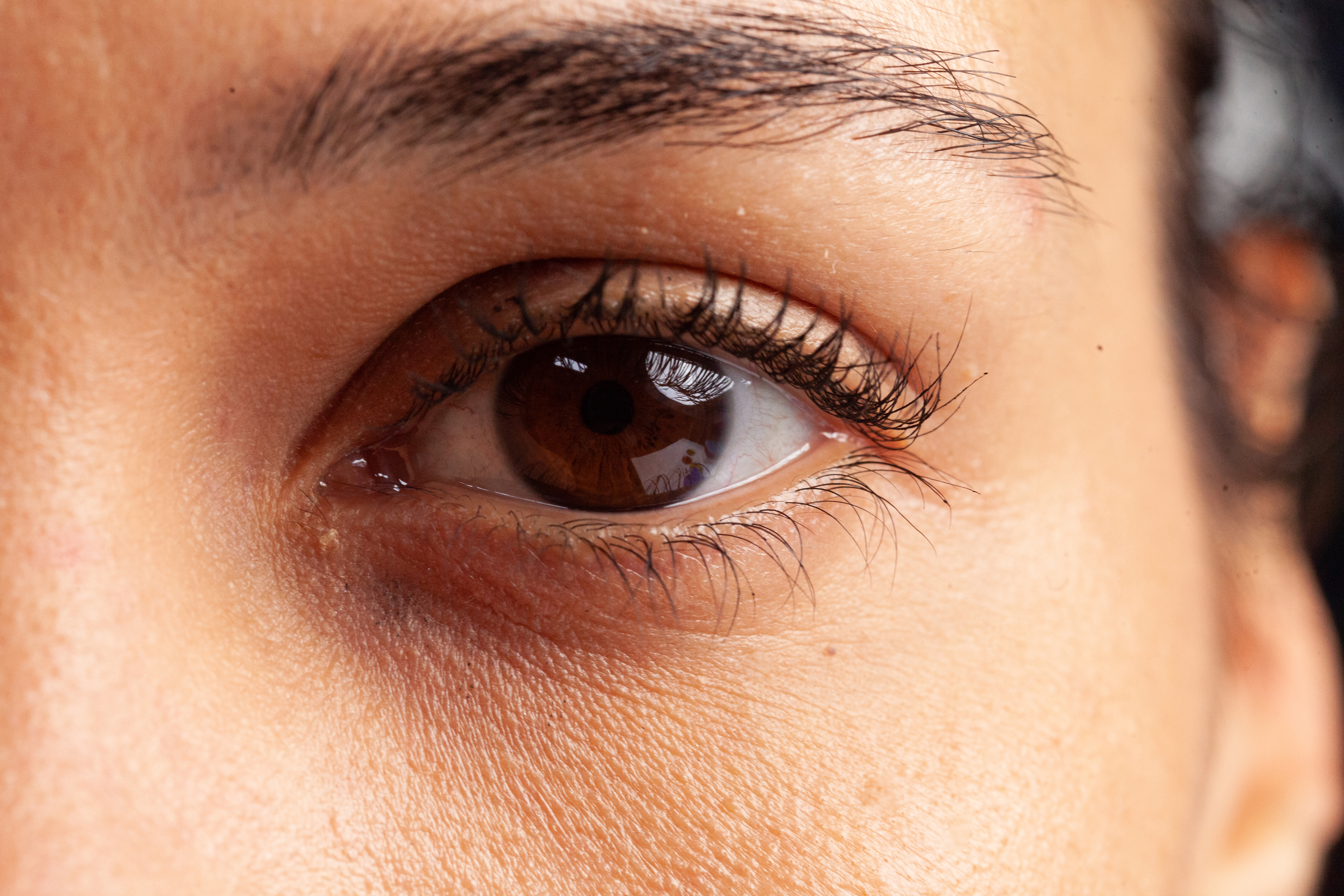Updated on October 9, 2024
What is the Rarest Eye Color? Debunking Myths


Vision Center is funded by our readers. We may earn commissions if you purchase something via one of our links.
Eye color is a fascinating part of human appearance. According to scientists, all eyes are brown. However, light reflecting from the iris (colored part of the eye) causes eyes to appear colored.

Some eye colors are common, while others are rare. Most people have come across brown and blue eyes (the most common eye colors). But what’s the rarest eye color?
In this article, we examine:
- Different eye colors, from the most common to the rarest
- How eye color is determined
- Factors affecting eye color change
What is the Rarest Eye Color?
Limited research exists to determine the rarest eye color. Some eye colors are rare in some regions, while they may be common in others. According to the World Atlas, it’s more common to see blue eyes in Europe, while it’s rare in Asia or Africa.1
Green is generally considered the rarest eye color, accounting for about 2% of the world’s population. The second rarest color is gray (3%), followed by hazel (5%).
An Overview of Eye Colors: From the Most Common to the Rarest
Here is a breakdown of the eye color percentages around the world. We’ll start from the most common to the rarest:
Brown
Scientists believe all eyes were brown before a genetic mutation occurred thousands of years ago. Currently, 70 to 80% of the world’s population has brown eyes, making brown the most common.4

About 45% of the U.S. population has brown eyes.5 Brown eyes are common among people of African and Asian descent, likely as an adaptation to hot climates in their regions.
People with brown eyes are less likely to suffer sun damage and eye conditions such as eye cancer, macular degeneration, and diabetic retinopathy due to a higher melanin concentration. However, dark brown eyes may be at higher risk of cataracts compared to light brown eyes.6
Blue
Blue is the second most common eye color in the world. It’s most common among people of European descent.

The genetic mutation that causes blue eyes first occurred in a single person in Europe between 6,000 to 10,000 years ago.7 The mutation reduced the amount of melanin in the iris.
Since then, the trait has been passed down through generations. The World Population Review estimates that 8 to 10% of people have blue eyes.4 U.S. estimates indicate 27% of the population has blue eyes.8
Hazel
Hazel is a mix of brown, green, and gold. Most hazel eyes have a different hue around the pupil and the outer rim of the eye, resulting in a “sunburst effect.”

According to research, 5% of the global population has hazel eyes. Hazel eyes are common among populations of North Africa, the Middle East, Brazil, and people of Spanish descent. In the U.S., 18% of people have hazel eyes.
Amber
Although some people classify amber and hazel eyes in the same category, the two are different. Amber eyes mix yellow and orange. They have slightly more melanin than hazel eyes but much less than brown eyes.
Only 5% of people globally have amber eyes. People of Asian, South American, Spanish, and South African descent are most likely to have amber eyes.
Gray
Gray is a rare eye color associated with little or no melanin in the irises. About 3% of the world’s population has gray eyes.
Gray-eyed people have more collagen fibers in the stroma, influencing how light reflects. The light entering their eyes scatters off collagen, making the eyes appear gray. Gray eyes can come in shades of light to dark gray.
Green
Green eyes have less melanin than brown eyes but more than blue eyes. Despite being rare (2% of the world’s population), green eyes are common in some parts of the world, such as Ireland, Scotland, and northern Europe (over 75%).9

Green eyes are also common in the U.S. (9%) owing to shared ancestry between Great Britain and the U.S. Studies often combine blue and gray, causing a mix-up in the statistics.
Research shows that Estonia, a Northern European country, may have the highest percentage of gray-eyed people. Almost 90% of the population has gray-blue eyes.10
Red or violet
True red or violet eyes affect less than 1% of the world’s population. They are common among people with ocular albinism (a condition that affects the iris pigmentation).

Black eyes
Black eyes are rare, accounting for less than 1% of the population. In most cases, black eyes result from genetic mutations.

There are two genetic conditions known to cause black eyes:
- Anisocoria. Differently-sized pupils characterize this condition. Sometimes, the pupil may be too large to notice the iris. The eye with a large pupil may appear black.
- Aniridia. This is when a person is born without an iris. These people may have giant pupils that make their eyes appear black. Some people with Aniridia may experience vision issues.
How is Eye Color Determined?
The amount of melanin in your iris determines your eye color. Genetics and certain health conditions can influence the amount of melanin in your eyes.
What Role Does Melanin Play in Eye Color?
According to research, melanin is a dark brown pigment responsible for eye, skin, and hair color.2 It also protects these organs and cells from the sun’s harmful UV (ultraviolet) rays. Melanin is produced in cells called melanocytes. In the eyes, melanocytes are found in the irises and pupils.
Brown eyes have more melanin, whereas blue and other color variations have less. Because melanin protects eyes against sun damage, people with color variations other than brown are at a higher risk of UV exposure.
Eyes with less melanin absorb less light and reflect more light. When light hits these eyes, it splits into various colors (Rayleigh scattering), causing them to appear hazel, gray, amber, green, red, or blue.
How Do Genes Influence Eye Color?
Research indicates about 16 genes influence eye color.3 Most play a role in melanin's production, transportation, or storage. One is OCA2, which is important for producing melanin. This gene produces a protein known as P-protein.
P-protein is responsible for the maturation of melanosomes (the cells that produce and store melanin). P-protein determines the amount and quality of melanin produced. Less P-protein causes less melanin production and lighter eye color.
Another significant gene influencing eye color is HERC2. It has a region that controls OCA2 gene activity by turning it on or off. Reduced OCA2 expression decreases P-protein production, producing less melanin in the iris.
Other genes influencing eye color include:
- ASIP
- IRF4
- SLC24A4
- SLC24A5
- SLC45A2
- TPCN2
- TYR
- TYRP1
The effects of these genes may combine to produce different eye colors in different people. Genetic variations can sometimes produce unexpected results, even when you can predict eye color based on parental eye color.
Rare Eye Conditions That Can Affect Eye Color
Many rare eye conditions can affect eye color.
| Waardenburg syndrome (1 in 40,000 people) | A person has a low concentration of melanin pigment, characterized by very light blue or different-colored eyes (partial albinism) |
| Horner’s syndrome (1.42 per 100,000 people under 19) | A symptom of Horner’s syndrome is when the iris of the affected eye takes a lighter color (iris heterochromia) |
| Iridocorneal endothelial (ICE) syndrome11 (common in women between the ages of 20 and 50) | Causes corneal swelling, changes in the iris, and glaucoma; involves cells moving from the cornea to the iris, distorting the iris color and causing other complications like glaucoma (increased eye pressure) |
| Kayser Fleischer ring (Affects 95% of people with Wilson Disease) | A person with greenish/orange ring in the cornea; associated with Wilson’s Disease (caused by the accumulation of copper in the body) |
| Fuchs heterochromic iridocyclitis (FHI) (accounts for 8% of all cases of endogenous uveitis) | A rare form of uveitis (inflammation of the uvea); causes inflammation of the iris and loss of iris pigmentation, affecting eye color |
What is Albinism and How Does it Affect Eye Color?
Albinism is a genetic disorder affecting about one in every 18,000 to 20,000 people in the U.S. and one in 3,000 people globally.12 People with albinism usually have little or no melanin in their skin, hair, and eyes (ocular albinism). Lack of melanin pigment causes these body parts to appear pale. Ocular albinism is also associated with vision issues such as:
- Depth perception
- Blurry vision
- Rapid, involuntary eye movements
- Light sensitivity
- Eyes that look in two different directions (strabismus)
Most people with albinism have blue, hazel, or brown eyes, depending on the amount of melanin pigmentation. Some people with albinism may appear to have red or violet eyes.
Studies show when there’s insufficient melanin to produce a blue color, the red reflections from blood vessels can combine with hues of blue to create light purple or violet eyes.13
Understanding Heterochromia
Two different-colored eyes characterize Heterochromia.14 Some people may have one iris with two colors. This condition affects less than 1% of the population.
Most cases of heterochromia are hereditary, while others result from injury or diseases such as glaucoma and Waardenburg syndrome.
There are three types of heterochromia:
- Complete heterochromia. Two differently colored eyes. This is the least common form.
- Sectoral (partial) heterochromia. Two colored eyes. The secondary color can cover a small part of one eye and take up two-thirds of the iris in another eye.
- Central heterochromia. Multicolored eyes. A different color near the pupil changes towards the iris edges. This condition affects both eyes.
Congenital heterochromia is usually harmless, but acquired heterochromia may indicate an underlying problem such as eye injury or disease. Talk to your doctor if you notice rapid eye color change.
Can Eye Color Change Over Time?
In most people, eye color remains the same throughout their life. Research shows most babies are born with blue eyes. However, light exposure causes the production of more melanin pigment, and eye color changes over the first few months. Most children attain a permanent eye color by the age of 1.
Some people may develop noticeably darker or lighter eyes with age. Changes in melanin levels and other factors such as genetics, disease, and injury can cause this. In some cases, brown freckles can develop in your iris due to sun exposure, influencing eye color change.
How Does Age Affect Eye Color?
Your eye color can change as you age, but it’s not a cause for concern in most cases. However, contact your healthcare provider if aging eyes show color change due to diseases, medication use, or injury.
Older adults with normal eyes may develop eyes that appear more gray or milky over time.
Can Injury or Health Conditions Change Eye Color?
Yes, an eye injury can cause iris tissue damage, causing tissue loss. When this occurs, the affected eye may appear differently colored.
Heterochromia (multicolored eyes) and anisocoria (differently sized pupils) have been documented in traumatic injuries. One example is rock star David Bowie, known for his hazel and light blue eye color. According to the New York Times, Bowie attributed his condition to a blow to the face during a teenage fistfight.15
Similarly, several health conditions can cause eye color change, including:
- Diabetes
- Iritis or uveitis
- Fuchs’ heterochromic cyclitis
- Glaucoma
- Acquired Horner’s syndrome
- Chediak-Higashi syndrome
- Posner-Schlossman syndrome
- Ocular melanosis
Seek medical advice if you notice a color change in one or both eyes.
Is It Safe to Change My Eye Color?
Invasive color change procedures like artificial iris implants are considered risky to vision. Although keratopigmentation is relatively safe, there is limited proof.
Considering the risks associated with other methods of changing eye color, eye doctors encourage color-changing contact lenses as a better alternative. Colored contacts have fewer risks as long as they are customized to individual needs.
Can You Change Your Eye Color?
There are several ways to change your eye color. Most people consider doing it for cosmetic reasons. As exciting as changing your eye color might sound, some procedures may interfere with vision.
The following are common ways to change eye color:
Laser surgery (Keratopigmentation)
Keratopigmentation (KTP) or corneal tattooing involves using a femtosecond laser device (like the one for LASIK surgery) to insert a special pigment into the cornea. This pigment covers your eyes’ natural pigment, producing a desired color.
According to a 2011 study published in the British Journal of Ophthalmology, KTP is an effective method for changing eye color.16 Follow-up studies on the effectiveness of this procedure indicate high satisfaction among beneficiaries.
Iris implant surgery
Iris implant surgery is more invasive than laser eye color change. It involves making an incision on the cornea and inserting an artificial iris into the iris layer.
Although this procedure is marketed as safe, its invasive nature poses a risk of eye damage if not done correctly. The American Academy of Ophthalmology (AAO) discourages people from undergoing this procedure, citing that iris implants can permanently damage eyes and vision.17
Colored contact lenses
Considering the risks associated with other methods of changing eye color, eye doctors encourage color-changing contact lenses as a better alternative. Although considered cosmetic, these can only be obtained through a prescription.
However, colored contacts have their risks. For example, non-prescription contacts can cut, scratch, and infect your eye if they don’t fit well or are not used properly.
Regardless of your contact lenses, talk to your doctor for guidance on the right size, proper use, and care. They will also be able to monitor you for any problems arising.
Summary
- Green is generally the rarest eye color, accounting for about 2% of the world’s population.
- The amount of melanin in your iris determines your eye color. Brown eyes have a high amount of melanin, whereas blue eyes and other color variations have less.
- About 16 genes influence eye color by instructing melanin's production, transportation, and storage.
- In most people, eye color remains the same throughout life, but factors like age, eye injury, and disease can affect eye color in adulthood.
- You can change your eye color for cosmetic reasons but do so in consultation with a medical specialist to avoid complications.
In this article
17 sources cited
Updated on October 9, 2024
Updated on October 9, 2024
About Our Contributors
Vincent Ayaga is a medical researcher and seasoned content writer with a bachelor's degree in Medical Microbiology. Specializing in disease investigation, prevention, and control, Vincent is dedicated to raising awareness about visual problems and the latest evidence-based solutions in ophthalmology. He strongly believes in the transformative power of ophthalmic education through research to inform and educate those seeking knowledge in eye health.
Dr. Melody Huang is an optometrist and freelance health writer with a passion for educating people about eye health. With her unique blend of clinical expertise and writing skills, Dr. Huang seeks to guide individuals towards healthier and happier lives. Her interests extend to Eastern medicine and integrative healthcare approaches. Outside of work, she enjoys exploring new skincare products, experimenting with food recipes, and spending time with her adopted cats.

